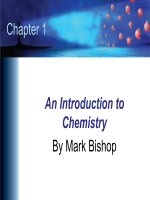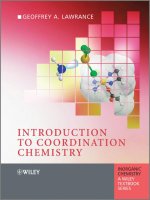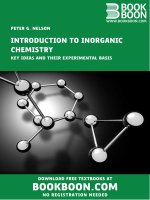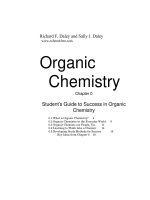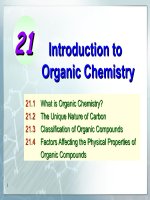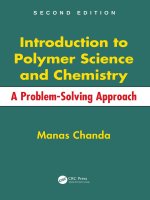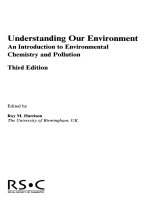Introduction to organic chemistry
Bạn đang xem bản rút gọn của tài liệu. Xem và tải ngay bản đầy đủ của tài liệu tại đây (19.2 MB, 844 trang )
This page intentionally left blank
Introduction to
Organic Chemistry
FIFTH EdITIon
This page intentionally left blank
Introduction to
Organic Chemistry
FIFTH EdITIon
William H. BrOWn
THOmas POOn
Beloit College
Claremont McKenna College
Scripps College
Pitzer College
J o h n W i l ey & S o nS , i nc .
Vp & Publisher: Kaye pace
Associate Publisher & Acquisition Editor: petra Recter
Senior Project Editor: Jennifer Yee
Marketing Manager: Kristine Ruff
Production Manager: Juanita Thompson
Senior Production Editor: Sandra Dumas
Designer: Wendy Lai
Senior Product Designer: Bonnie Roth
Media Specialist: Lana Barskaya
Editorial Assistant: Ashley Gayle
Photo Department Manager: Hilary Newman
Photo Editor: Lisa Gee
Production Management Services: cMpreparé/Francesca Monaco
This book was typeset in 10/12 New Baskerville at cMpreparé and printed and bound by Courier/Kendallville. The
cover was printed by Courier/Kendallville.
The paper in this book was manufactured by a mill whose forest management programs include sustained yield harvesting of its timberlands. Sustained yield harvesting principles ensure that the number of trees cut each year does not
exceed the amount of new growth.
This book is printed on acid-free paper.
Copyright © 2014, 2011, 2005, 2000 by John Wiley & Sons, Inc. All rights reserved.
No part of this publication may be reproduced, stored in a retrieval system or transmitted in any form or by any
means, electronic, mechanical, photocopying recording, scanning or otherwise, except as permitted under Sections
107 or 108 of the 1976 United States Copyright Act, without either the prior written permission of the publisher or
authorization through payment of the appropriate per-copy fee to the Copyright Clearance Center, 222 Rosewood
Drive, Danvers, MA 01923, (978) 750-8400, fax (978) 646-8600. Requests to the publisher for permission should
be addressed to the permissions Department, John Wiley & Sons, Inc., 111 River Street, Hoboken, NJ 07030-5774,
(201) 748-6011, fax (201) 748-6008.
Evaluation copies are provided to qualified academics and professionals for review purposes only, for use in their
courses during the next academic year. These copies are licensed and may not be sold or transferred to a third party.
Upon completion of the review period, please return the evaluation copy to Wiley. Return instructions and a free of
charge return shipping label are available at www.wiley.com/go/returnlabel. Outside of the United States, please
contact your local representative.
978-1118-083383
978-1118-152188
printed in the United States of America.
10 9 8 7 6 5 4 3 2 1
To Carolyn,
with whom life is a joy
Bill Brown
To Sophia,
sky, fish, fireworks
Thomas Poon
This page intentionally left blank
A b o u t th e A u t h o r s
William H. BroWn is professor emeritus at Beloit college, where he was twice
named Teacher of the year. he is also the author of two other college textbooks: Organic
Chemistry 5/e, coauthored with chris Foote, Brent iverson, and eric Anslyn, published in
2009, and General, Organic, and Biochemistry 9/e, coauthored with Fred Bettelheim, Mary
campbell, and Shawn Farrell, published in 2010. he received his ph.D. from columbia
University under the direction of Gilbert Stork and did postdoctoral work at california
institute of Technology and the University of Arizona. Twice he was Director of a Beloit
college World Affairs center seminar at the University of Glasgow, Scotland. in 1999, he
retired from Beloit college to devote more time to writing and development of educational
materials. Although officially retired, he continues to teach Special Topics in organic Synthesis on a yearly basis.
Bill and his wife carolyn enjoy hiking in the canyon country of the Southwest. in addition, they both enjoy quilting and quilts.
THomas Poon is professor of chemistry in the W.M. Keck Science Department of
claremont McKenna, pitzer, and Scripps colleges, three of the five undergraduate institutions that make up the claremont colleges in claremont, california. he received his B.S.
degree from Fairfield University (cT) and his ph.D. from the University of california, los
Angeles under the direction of christopher S. Foote. poon was a camille and henry Dreyfus postdoctoral Fellow under Bradford p. Mundy at colby college (Me) before joining the
faculty at Randolph-Macon college (VA) where he received the Thomas Branch Award for
excellence in Teaching in 1999. he was a visiting scholar at columbia University (ny) in
2002 (and again in 2004) where he worked on projects in both research and education with
his friend and mentor, nicholas J. Turro. he has taught organic chemistry, forensic chemistry, upper-level courses in advanced laboratory techniques, and a first-year seminar class
titled Science of Identity. his favorite activity is working alongside undergraduates in the
laboratory on research problems involving the investigation of synthetic methodology in
zeolites, zeolite photochemistry, natural products isolation, and reactions of singlet oxygen.
When not in the lab, he likes to play guitar and sing chemistry songs to his daughter
Sophie.
vii
This page intentionally left blank
C o n t e n ts ov e r v i e w
01
02
03
04
05
06
07
08
09
10
11
Covalent Bonding and
Shapes of Molecules 1
Acids and Bases
41
Alkanes and Cycloalkanes 63
Alkenes and Alkynes
108
Reactions of Alkenes and Alkynes
Chirality: The Handedness
of Molecules 167
Haloalkanes
200
Alcohols, Ethers, and Thiols 239
Benzene and Its derivatives
Amines
331
282
129
12
13
14
15
16
17
18
19
20
21
Aldehydes and Ketones 416
Carboxylic Acids 457
Functional derivatives of
Carboxylic Acids 488
Enolate Anions 526
organic Polymer Chemistry 564
Carbohydrates 586
Amino Acids and Proteins 619
Lipids
649
nucleic Acids (online Chapter) 674
The organic Chemistry
of Metabolism (online Chapter) 700
Spectroscopy 361
ix
Contents
01
Summary of Key Questions 57
Covalent Bonding and
shapes of molecules 1
Quick Quiz
58
Key Reactions 59
1.1
How do We describe the Electronic
Structure of Atoms? 2
Problems 59
1.2
What Is the Lewis Model of Bonding? 5
Group Learning Activities
1.3
How do We Predict Bond Angles and the
Shapes of Molecules? 14
1.4
How do We Predict If a Molecule Is
Polar or nonpolar? 18
1.5
What Is Resonance? 19
1.6
What Is the orbital overlap Model of
Covalent Bonding? 22
1.7
What Are Functional Groups?
Looking Ahead 62
28
Summary of Key Questions 32
Quick Quiz
Problems
34
35
Looking Ahead
40
Group Learning Activities
40
03
Buckyball: A new Form of Carbon
02
acids and Bases
17
41
alkanes and Cycloalkanes 63
3.1
What Are Alkanes?
3.2
What Is Constitutional Isomerism in
Alkanes? 66
3.3
How do We name Alkanes?
3.4
What Are Cycloalkanes? 73
3.5
What Is the IUPAC System of
nomenclature? 75
3.6
What Are the Conformations of Alkanes and
Cycloalkanes? 76
3.7
What Is Cis–Trans Isomerism in
Cycloalkanes? 83
3.8
What Are the Physical Properties of Alkanes
and Cycloalkanes? 87
3.9
What Are the Characteristic Reactions of
Alkanes? 91
3.10
What Are the Sources of Alkanes? 91
CHEmiCal COnnECTiOns
1a
64
2.1
What Are Arrhenius Acids and
Bases? 42
2.2
What Are Brønsted–Lowry Acids and
Bases? 43
Quick Quiz 96
2.3
How do We Measure the Strength of an
Acid or Base? 46
Problems 97
2.4
How do We determine the
Position of Equilibrium in an
Acid–Base Reaction? 48
Group Learning Activities
2.5
2.6
x
What Are the Relationships
between Acidity and Molecular
Structure? 50
What Are Lewis Acids and Bases? 54
62
69
Summary of Key Questions 94
Key Reactions 97
Looking Ahead 102
104
Putting It Together 104
CHEmiCal COnnECTiOns
3a
The Poisonous Puffer Fish
3B
octane Rating: What Those numbers at the
Pump Mean 94
84
COnTEnTs
04
alkenes and alkynes 108
Looking Ahead 165
Group Learning Activities 166
CHEmiCal COnnECTiOns
4.1
What Are the Structures and Shapes
of Alkenes and Alkynes? 110
4.2
How do We name Alkenes and Alkynes? 112
4.3
What Are the Physical Properties
of Alkenes and Alkynes? 120
4.4
Why Are 1-Alkynes (Terminal Alkynes)
Weak Acids? 122
Summary of Key Questions 123
Quick Quiz
124
5a
Catalytic Cracking and the Importance of
Alkenes 133
06
Chirality: The Handedness
of molecules 167
6.1
What Are Stereoisomers? 168
6.2
What Are Enantiomers? 169
6.3
How do We designate the Configuration
of a Stereocenter? 173
CHEmiCal COnnECTiOns
6.4
What Is the 2n Rule? 176
4a
Ethylene, a Plant Growth
Regulator 109
6.5
How do We describe the Chirality of Cyclic
Molecules with Two Stereocenters? 180
4B
Cis–Trans Isomerism in Vision 111
6.6
4C
Why Plants Emit Isoprene
How do We describe the Chirality
of Molecules with Three or More
Stereocenters? 182
6.7
What Are the Properties of
Stereoisomers? 183
6.8
How Is Chirality detected in the
Laboratory? 184
6.9
What Is the Significance of Chirality
in the Biological World? 185
6.10
How Can Enantiomers Be Resolved? 186
Problems
124
Looking Ahead
128
Group Learning Activities
05
128
121
reactions of alkenes and
alkynes 129
5.1
What Are the Characteristic Reactions of
Alkenes? 130
5.2
What Is a Reaction Mechanism? 130
5.3
What Are the Mechanisms of
Electrophilic Additions to Alkenes? 136
5.4
What Are Carbocation
Rearrangements? 147
Looking Ahead 196
5.5
What Is Hydroboration–oxidation of
an Alkene? 150
Putting It Together 196
5.6
How Can an Alkene Be Reduced to an
Alkane? 153
5.7
How Can an Acetylide Anion Be
Used to Create a new Carbon–Carbon
Bond? 155
5.8
How Can Alkynes Be Reduced to Alkenes
and Alkanes? 157
Summary of Key Questions 158
Quick Quiz
159
Key Reactions 160
Problems
161
Summary of Key Questions 189
Quick Quiz 190
Problems 191
Chemical Transformations 195
Group Learning Activities 196
CHEmiCal COnnECTiOns
6a
Chiral drugs
07
187
Haloalkanes 200
7.1
How Are Haloalkanes named? 201
7.2
What Are the Characteristic Reactions
of Haloalkanes? 203
xi
xii
COnTEnTs
7.3
What Are the Products of nucleophilic
Aliphatic Substitution Reactions? 206
CHEmiCal COnnECTiOns
8a
nitroglycerin: An Explosive and a drug 243
7.4
What Are the Sn2 and Sn1 Mechanisms
for nucleophilic Substitution? 208
8B
Blood Alcohol Screening 260
8C
Ethylene oxide: A Chemical Sterilant 268
7.5
What determines Whether Sn1
or Sn2 Predominates? 211
7.6
How Can Sn1 and Sn2 Be Predicted Based
on Experimental Conditions? 217
7.7
What Are the Products of
b-Elimination? 219
7.8
What Are the E1 and E2 Mechanisms
for b-Elimination? 222
7.9
When do nucleophilic Substitution
and b-Elimination Compete? 225
What Is the Structure of Benzene? 283
9.2
What Is Aromaticity? 286
9.3
How Are Benzene Compounds named, and
What Are Their Physical Properties? 289
9.4
What Is the Benzylic Position, and How does
It Contribute to Benzene Reactivity? 292
9.5
What Is Electrophilic Aromatic
Substitution? 295
236
9.6
What Is the Mechanism of Electrophilic
Aromatic Substitution? 296
238
9.7
How do Existing Substituents on
Benzene Affect Electrophilic Aromatic
Substitution? 305
9.8
What Are Phenols? 314
229
230
Key Reactions 231
Problems
231
Chemical Transformations
Looking Ahead
237
Group Learning Activities
282
9.1
Summary of Key Questions
Quick Quiz
09
Benzene and
its Derivatives
CHEmiCal COnnECTiOns
7a
The Environmental Impact
of Chlorofluorocarbons 204
7B
The Effect of Chlorofluorocarbon
Legislation on Asthma Sufferers 228
Summary of Key Questions 321
Quick Quiz
322
Key Reactions 322
Problems 324
08
Chemical Transformations
alcohols, Ethers,
and Thiols 239
Looking Ahead 330
Group Learning Activities
What Are Alcohols?
8.2
What Are the Characteristic
Reactions of Alcohols? 246
8.3
What Are Ethers? 260
8.4
What Are Epoxides? 264
8.5
What Are Thiols? 268
8.6
What Are the Characteristic Reactions
of Thiols? 271
240
Summary of Key Questions 272
274
Key Reactions 274
Problems
275
Chemical Transformations
Looking Ahead
279
280
Group Learning Activities
330
CHEmiCal COnnECTiOns
8.1
Quick Quiz
329
281
9a
Carcinogenic Polynuclear Aromatics and
Cancer 293
9B
Capsaicin, for Those Who Like It Hot 318
10
amines
331
10.1
What Are Amines? 333
10.2
How Are Amines named? 334
10.3
What Are the Characteristic Physical
Properties of Amines? 337
10.4
What Are the Acid–Base Properties of
Amines? 340
COnTEnTs
10.5
What Are the Reactions of Amines with
Acids? 344
10.6
How Are Arylamines Synthesized?
10.7
How do Amines Act as nucleophiles? 347
CHEmiCal COnnECTiOns
11a
Infrared Spectroscopy: A Window on Brain
Activity 368
11B
Magnetic Resonance Imaging 391
346
Summary of Key Questions 349
Quick Quiz 350
Key Reactions 350
Problems
351
Chemical Transformations 356
Looking Ahead
357
Group Learning Activities
357
12
12.1
What Are Aldehydes and Ketones?
12.2
How Are Aldehydes and Ketones
named? 417
12.3
What Are the Physical Properties of
Aldehydes and Ketones? 421
Putting It Together 357
CHEmiCal COnnECTiOns
aldehydes and Ketones
416
417
10a
Morphine as a Clue in the design and
discovery of drugs 332
12.4
10B
The Poison dart Frogs of South America:
Lethal Amines 338
What Is the Most Common Reaction Theme
of Aldehydes and Ketones? 422
12.5
What Are Grignard Reagents, and How
do They React with Aldehydes and
Ketones? 423
12.6
What Are Hemiacetals and Acetals? 427
12.7
How do Aldehydes and Ketones React
with Ammonia and Amines? 434
12.8
What Is Keto–Enol Tautomerism?
12.9
How Are Aldehydes and Ketones
oxidized? 441
11
spectroscopy
361
11.1
What Is Electromagnetic Radiation? 362
11.2
What Is Molecular Spectroscopy? 364
11.3
What Is Infrared Spectroscopy? 364
11.4
How do We Interpret Infrared Spectra? 367
Summary of Key Questions 445
11.5
What Is nuclear Magnetic Resonance? 378
Quick Quiz
11.6
What Is Shielding?
Key Reactions 447
11.7
What Is an nMR Spectrum? 380
Problems 448
11.8
How Many Resonance Signals
Will a Compound Yield in Its nMR
Spectrum? 382
Chemical Transformations
11.9
12.10 How Are Aldehydes and Ketones
Reduced? 443
380
11.11 What Is Signal Splitting? 388
11.12 What Is 13C-nMR Spectroscopy, and
How does It differ from 1H-nMR
Spectroscopy? 391
11.13 How do We Solve an nMR
Problem? 394
Summary of Key Questions 398
Quick Quiz
Problems
400
401
Looking Ahead
414
Group Learning Activities
415
447
Spectroscopy
454
455
Looking Ahead 456
What Is Signal Integration? 385
11.10 What Is Chemical Shift? 386
437
Group Learning Activities
456
CHEmiCal COnnECTiOns
12a
A Green Synthesis of Adipic Acid 442
13
Carboxylic acids
457
13.1
What Are Carboxylic Acids?
13.2
How Are Carboxylic Acids named? 458
13.3
What Are the Physical Properties
of Carboxylic Acids? 461
458
xiii
xiv
COnTEnTs
13.4
What Are the Acid–Base Properties
of Carboxylic Acids? 462
CHEmiCal COnnECTiOns
14a
Ultraviolet Sunscreens and Sunblocks 490
13.5
How Are Carboxyl Groups Reduced? 466
14B
From Moldy Clover to a Blood Thinner 491
13.6
What Is Fischer Esterification?
14C
13.7
What Are Acid Chlorides? 473
The Penicillins and Cephalosporins:
b-Lactam Antibiotics 492
13.8
What Is decarboxylation? 475
14D
The Pyrethrins: natural Insecticides of
Plant origin 503
14E
Systematic Acquired Resistance in Plants 506
470
Summary of Key Questions 479
Quick Quiz
480
Key Reactions 480
Problems
481
Chemical Transformations
Looking Ahead
486
487
Group Learning Activities
487
CHEmiCal COnnECTiOns
15
Enolate anions 526
15.1
What Are Enolate Anions, and How
Are They Formed? 527
Esters as Flavoring Agents 472
15.2
What Is the Aldol Reaction?
Ketone Bodies and diabetes
15.3
What Are the Claisen and dieckmann
Condensations? 537
15.4
How Are Aldol Reactions and Claisen
Condensations Involved in Biological
Processes? 545
15.5
What Is the Michael Reaction? 547
13a
From Willow Bark to Aspirin and Beyond 466
13B
13C
14
476
Functional Derivatives of
Carboxylic acids 488
Summary of Key Questions 554
Quick Quiz
554
14.1
What Are Some derivatives of Carboxylic
Acids, and How Are They named? 489
14.2
What Are the Characteristic Reactions of
Carboxylic Acid derivatives? 495
Problems 556
14.3
What Is Hydrolysis?
Looking Ahead 562
14.4
How do Carboxylic Acid derivatives
React with Alcohols? 501
14.5
How do Carboxylic Acid derivatives React
with Ammonia and Amines? 503
14.6
How Can Functional derivatives of
Carboxylic Acids Be Interconverted? 505
14.7
How do Esters React with Grignard
Reagents? 507
14.8
How Are derivatives of Carboxylic Acids
Reduced? 509
Quick Quiz 514
Key Reactions 515
Problems
516
Chemical Transformations 522
Looking Ahead
Key Reactions 555
Chemical Transformations
496
Summary of Key Questions 513
523
Group Learning Activities
561
563
CHEmiCal COnnECTiOns
15a
drugs That Lower Plasma Levels of
Cholesterol 546
15B
Antitumor Compounds: The Michael
Reaction in nature 553
16
Organic Polymer
Chemistry 564
16.1
What Is the Architecture of Polymers? 565
16.2
How do We name and Show the Structure
of a Polymer? 565
16.3
What Is Polymer Morphology? Crystalline
versus Amorphous Materials 567
16.4
What Is Step-Growth Polymerization? 568
Group Learning Activities 523
Putting It Together 523
530
COnTEnTs
16.5
What Are Chain-Growth Polymers? 573
18.3
16.6
What Plastics Are Currently Recycled
in Large Quantities? 579
What Are the Acid–Base Properties of
Amino Acids? 623
18.4
What Are Polypeptides and Proteins? 630
Summary of Key Questions 580
18.5
What Is the Primary Structure of a
Polypeptide or Protein? 631
18.6
What Are the Three-dimensional Shapes
of Polypeptides and Proteins? 635
Quick Quiz
581
Key Reactions 582
Problems
582
Looking Ahead
Summary of Key Questions 642
584
Group Learning Activities
Quick Quiz 643
585
Key Reactions 644
CHEmiCal COnnECTiOns
16a
Stitches That dissolve 573
16B
Paper or Plastic?
17
Problems 645
Looking Ahead 648
575
Group Learning Activities 648
CHEmiCal COnnECTiOns
Carbohydrates
586
17.1
What Are Carbohydrates?
17.2
What Are Monosaccharides?
17.3
What Are the Cyclic Structures
of Monosaccharides? 591
17.4
What Are the Characteristic Reactions
of Monosaccharides? 596
17.5
What Are disaccharides and
oligosaccharides? 601
17.6
586
587
18a
19
What Are Triglycerides? 650
19.2
What Are Soaps and detergents?
19.3
What Are Phospholipids?
19.4
What Are Steroids? 657
Summary of Key Questions 606
19.5
What Are Prostaglandins? 662
Quick Quiz
19.6
What Are Fat-Soluble Vitamins? 665
What Are Polysaccharides?
604
608
Summary of Key Questions 668
Problems
Quick Quiz 669
609
Problems 669
614
Looking Ahead 672
614
Group Learning Activities 673
Putting It Together 615
CHEmiCal COnnECTiOns
CHEmiCal COnnECTiOns
Relative Sweetness of Carbohydrate
and Artificial Sweeteners 602
18.2
19a
Snake Venom Phospholipases 657
19B
nonsteroidal Estrogen Antagonists
661
A, B, AB, and o Blood-Group
Substances 603
18
18.1
653
655
Key Reactions 608
Group Learning Activities
17B
lipids 649
19.1
Looking Ahead
17a
Spider Silk: A Chemical and Engineering
Wonder of nature 640
amino acids and
Proteins 619
20
nucleic acids
(Online Chapter) 674
20.1
What Are the Many Functions of
Proteins? 620
What Are nucleosides and
nucleotides? 675
20.2
What Is the Structure of dnA?
What Are Amino Acids?
20.3
What Are Ribonucleic Acids (RnA)? 685
620
678
xv
xvi
COnTEnTs
20.4
What Is the Genetic Code? 687
20.5
How Is dnA Sequenced?
Problems
696
What Are the Reactions of the Citric Acid
Cycle? 717
Quick Quiz
699
20a
The Search for Antiviral drugs
20B
dnA Fingerprinting
721
Key Reactions 722
CHEmiCal COnnECTiOns
21.1
21.6
Summary of Key Questions 720
696
Group Learning Activities
21
What Are the Reactions of the b-oxidation
of Fatty Acids? 713
689
Summary of Key Questions 694
Quick Quiz
21.5
677
694
The Organic Chemistry of
metabolism
(Online Chapter) 700
What Are the Key Participants in
Glycolysis, the b-oxidation of Fatty Acids,
and the Citric Acid Cycle? 701
Problems 722
Group Learning Activities
appendix 1
acid ionization Constants
for the major Classes of
Organic acids a.1
appendix 2
Characteristic 1H-nmr Chemical
shifts a.2
appendix 3
Characteristic 13C-nmr Chemical
shifts a.3
appendix 4
Characteristic infrared absorption
Frequencies a.4
21.2
What Is Glycolysis?
21.3
What Are the Ten Reactions of
Glycolysis? 707
Glossary G.1
What Are the Fates of Pyruvate? 711
index
21.4
706
724
answers section ans.1
i.1
P r e f A Ce
Goals of This Text
This text is designed for an introductory course in organic chemistry and assumes, as background, a
prior course of general chemistry. Both its form and content have been shaped by our experiences in
the classroom and by our assessment of the present and future direction of the brief organic course.
A brief course in organic chemistry must achieve several goals. First, most students who elect
this course are oriented toward careers in science, but few if any intend to become professional
chemists; rather, they are preparing for careers in areas that require a grounding in the essentials of
organic chemistry. here is the place to examine the structure, properties, and reactions of rather simple molecules. Students can then build on this knowledge in later course work and professional life.
Second, an introductory course must portray something of the scope and content of organic
chemistry as well as its tremendous impact on the ways we live and work. To do this, we have included specific examples of pharmaceuticals, plastics, soaps and detergents, natural and synthetic
textile fibers, petroleum refining, petrochemicals, pesticides, artificial flavoring agents, chemical
ecology, and so on at appropriate points in the text.
Third, a brief course must convince students that organic chemistry is more than just a catalog
of names and reactions. There are certain organizing themes or principles, which not only make the
discipline easier to understand, but also provide a way to analyze new chemistry. The relationship
between molecular structure and chemical reactivity is one such theme. electronic theory of organic
chemistry, including lewis structures, atomic orbitals, the hybridization of atomic orbitals, and the
theory of resonance are presented in chapter 1. chapter 2 explores the relationship between molecular structure and one chemical property, namely, acidity and basicity. Variations in acidity and basicity among organic compounds are correlated using the concepts of electronegativity, the inductive
effect, and resonance. These same concepts are used throughout the text in discussions of molecular
structure and chemical reactivity. Stereochemistry is a second theme that recurs throughout the text.
The concept and importance of the spatial arrangement of atoms is introduced in chapter 3 with the
concept of conformations in alkanes and cycloalkane, followed by cis/trans isomerism in chapters 3
(in cycloalkanes) and 4 (in alkenes). Molecular symmetry and asymmetry, enantiomers and absolute
configuration, and the significance of asymmetry in the biological world are discussed in chapter 6.
The concept of a mechanistic understanding of the reactions of organic substances is a third major
theme. Reaction mechanisms are first presented in chapter 5; they not only help to minimize memory work but also provide a satisfaction that comes from an understanding of the molecular logic that
governs how and why organic reactions occur as they do. in this chapter we present a set of five fundamental patterns that are foundational to the molecular logic of organic reactions. An understanding and application of these patterns will not only help to minimize memory work but also provide
a satisfaction that comes from an understanding of how and why organic reactions occur as they do.
The audience
This book provides an introduction to organic chemistry for students who intend to pursue
careers in the sciences and who require a grounding in organic chemistry. For this reason, we make
a special effort throughout to show the interrelation between organic chemistry and other areas of
science, particularly the biological and health sciences. While studying with this book, we hope
that students will see that organic chemistry is a tool for these many disciplines, and that organic
compounds, both natural and synthetic, are all around them—in pharmaceuticals, plastics, fibers,
agrochemicals, surface coatings, toiletry preparations and cosmetics, food additives, adhesives,
xvii
xviii
5.3
What Are the Mechanisms of Electrophilic Additions to Alkenes?
137
P r E Fa C E
S T R AT E g Y
Use Markovnikov’s rule, which predicts that H adds to the least substituted carbon of the double bond and halogen adds to
the more substituted carbon.
and elastomers. Furthermore, we hope that students will recognize that organic chemistry is a
hydrogen of
dynamic and ever-expanding area ofthescience
waiting openly for those who are prepared, both by
HCl is added to
CH 3
training
and an inquisitive nature, to this
askcarbon
questions and explore.
ƒ
SOLUTION
(a) CH 3CCH 3
(b)
ƒ
I
Cl
CH3
new to This Edition
1-Chloro-1-methylcyclopentane
2-Iodo-2-methylpropane
See problems 5.17–5.20, 5.28
● o
p●r
b l E m 5.2boxes have been added for each mechanism in the book. These Mecha“Mechanism”
nism boxes serve as road maps and are a new way of presenting mechanisms using basic
steps and recurring themes that are common to most organic reaction mechanisms. This
CH2+HI have
¡ many steps in common, and it makes
(a) CH
+ HI ¡students to(b)see that reactions
approach
3CH “ CH 2 allows
the reactions easier to understand and remember. By graphically highlighting the mechanisms in
the for
text,
we emphasize
importance
of mechanisms
Chemists
account
the addition
of HX to anthe
alkene
by a two-step mechanism,
which for learning organic chemwe illustrate
the reaction
of 2-buteneare
witheasier
hydrogen
chloride
to give 2-chlorobutane.
us
sitry,byand
mechanisms
for
the students
to locateLetquickly.
Name and draw a structural formula for the major product of each alkene addition reaction:
first look at this two-step mechanism in general and then go back and study each step in detail.
Mechanism
electrophilic addition of hCl to 2-Butene
STEp 1: Add a proton. The reaction begins with the transfer of a proton from HCl to 2-butene, as shown
by the two curved arrows on the left side of Step 1:
⁄
d+
d-
CH3CH “ CHCH 3 + H ¬ Cl
H
ƒ
+
CH3C H ¬ CHCH3 + Cl
slow, rate
determining
⁄
(a nucleophile)
sec-Butyl cation
(a 2° carbocation
intermediate)
(an electrophile)
The first curved arrow shows the breaking of the pi bond of the alkene and its electron pair now
forming a new covalent bond with the hydrogen atom of HCl. In this step, the carbon–carbon
double bond of the alkene is the nucleophile (the electron-rich, nucleus-seeking species) and
HCl is the electrophile (the electron-poor, electron-seeking species). The second curved arrow
shows the breaking of the polar covalent bond in HCl and this electron pair being given entirely
to chlorine, forming chloride ion. Step 1 in this mechanism results in the formation of an organic
cation and chloride ion.
STEp 2: Reaction of an electrophile and a nucleophile to form a new covalent bond. The reaction of the
sec-butyl cation (an electrophile and a Lewis acid) with chloride ion (a nucleophile and a Lewis
base) completes the valence shell of carbon and gives 2-chlorobutane:
Cl
-
+
+ CH3C HCH2CH3
Chloride ion sec -Butyl cation
(a Lewis base) (a Lewis acid)
(a nucleophile) (an electrophile)
●●
Brown_c05_129-166hr.indd
fast
"
Cl
ƒ
CH3CHCH 2CH3
2-Chlorobutane
new “Group Learning Activities” appear with the end-of-chapter problems, and provide
students with the opportunity to learn organic chemistry collaboratively. This will encourage
137
8/7/12 2:27 PM
students to work in groups and foster more active learning in their studying.
G R O U P L E A R N I N G AC T I V I T I E S
5.55
Take turns quizzing each other on the reactions
presented in this chapter in the following ways:
(a) Say the name of a reaction and ask each other
to come up with the reagents and products of
that reaction. For example, if you say “catalytic
hydrogenation of an alkene” the answer should
be “H2/Pt reacts to give an alkane.”
(b) Describe a set of reagents and ask each other
what functional group(s) the reagents react
with. For example, if you say “H2/Pt,” the
answer should be “alkenes” and “alkynes.”
(c) Name a functional group or class of compound
as a product of a reaction and ask what functional group or class of compound could be
used to synthesize that product. For example,
if you say “alkene,” the answer should be
“alkyne.”
5.56
Using a piece of paper or, preferably, a whiteboard
or chalkboard, take turns drawing the mechanisms
of each reaction in this chapter from memory. If you
forget a step or make a mistake, another member of
the group should step in and finish it.
5.57
With the exception of ethylene to ethanol, the acidcatalyzed hydration of alkenes cannot be used for the
synthesis of primary alcohols. Explain why this is so.
P r E Fa C E
●●
●●
●●
Due to overwhelming demand, we have combined the chapters on organic spectroscopic techniques into one chapter, chapter 11, while still providing a sound conceptual treatise on
organic spectroscopy. in combining the chapters, students are shown that the absorption of
electromagnetic radiation and transitions between energy states are common themes to both
infrared spectroscopy and nMR spectroscopy.
“Key Terms and Concepts” now appear within the “Summary of Key Questions.” in doing
so, we shift the emphasis from simply memorizing a list of terms to seeing the terms (highlighted in bold) in the context of important conceptual questions.
We have reduced the length of the text. Using reviewer input and feedback from instructors
who have used the text, we removed material that we identified as being less important to our
audience’s learning of organic chemistry. We also moved some chapters online, to the text
website and to WileyPLUS. The result is a manageable amount of material that still provides
a thorough introduction to organic chemistry. chapter 20, nucleic Acids, and chapter 21,
The organic chemistry of Metabolism, will be available in WileyPLUS and at the text website:
www.wiley.com/college/brown.
special Features
“How To” Boxes: have your students ever wished for an easy-to-follow, step-by-step guide to
understanding a problem or concept? We have identified topics in nearly every chapter that often
give students a difficult time and created step-by-step How To guides for approaching them.
Correct use of curved arrows...
H +
H Br≠
H
+
H
H
H
H
+ ≠Br≠
≠ ≠
H
≠ ≠
Incorrect use of curved arrows...
H
H +
H Br≠
H
H
+
H
H
H
+ ≠Br≠
a common mistake is to use curved arrows to indicate
the movement of atoms rather than electrons
Chemical Connection Boxes include applications of organic chemistry to the world around
us, particularly to the biochemical, health, and biological sciences. The topics covered in
these boxes represent real-world applications of organic chemistry and highlight the relevance
between organic chemistry and the students’ future careers.
“Putting It Together” Cumulative Review Questions: in this text, end-of-chapter problems are
organized by section, allowing students to easily refer back to the chapter if difficulties arise. This
way of organizing practice problems is very useful for learning new material. Wouldn’t it be helpful for students to know whether they could do a problem that wasn’t categorized for them (i.e., to
know whether they could recognize that problem in a different context, such as an exam setting)?
To help students in this regard, we have added a section called Putting It Together (piT) at the end
of chapters 3, 6, 10, 14, and 17. each piT section is structured much like an exam would be organized, with questions of varying type (multiple choice, short answer, naming, mechanism problems, predict the products, synthesis problems, etc.) and difficulty (often requiring knowledge of
concepts from two or more previous chapters). Students’ performance on the piT questions will
≠ ≠
Mechanisms show how bonds are broken
and formed. Although individual atoms
may change positions in a reaction, the
curved arrows used in a mechanism are
only for the purpose of showing electron
movement. Therefore, it is important to
remember that curved arrow notation
always shows the arrow originating from
a bond or from an unshared electron pair
(not the other way around).
≠ ≠
HOW TO 5.1
Draw Mechanisms
xix
xx
P r E Fa C E
aid them in assessing their knowledge of the concepts from these groupings of chapters. The solutions to the putting it Together questions appear in the Student Solutions Manual.
Problem-Solving Strategies: one of the greatest difficulties students often encounter when
attempting to solve problems is knowing where to begin. To help students overcome this challenge, we include a Strategy step for every worked example in the text. The strategy step will help
students to determine the starting point for each of the example problems. once students are
familiar with the strategy, they can apply it to all problems of that type.
EXAMPLE
5.5
Draw a structural formula for the product of the acid-catalyzed hydration of 1-methylcyclohexene.
S T R AT E G Y
Use Markovnikov’s rule, which states that the H adds to the carbon of the carbon–carbon double bond bearing the greater
number of hydrogens and that OH adds to the carbon bearing the lesser number of hydrogens.
SOLUTION
CH3
CH3
+H2O
1-Methylcyclohexene
H2SO4
OH
1-Methylcyclohexanol
See problems 5.19, 5.20, 5.28, 5.32
Quick Quizzes: Research on reading comprehension has shown that good readers self-monitor
their understanding of what they have just read. We have provided a tool that will allow students
to do this, called the Quick Quiz. Quick quizzes are a set of true or false questions at the end
of every chapter designed to test students’ understanding of the basic concepts presented in the
chapter. The questions are not designed to be an indicator of their readiness for an exam. Rather,
they are provided for students to assess whether they have the bare minimum of knowledge needed
QUICK QUIZ
Answer true or false to the following questions to assess your general knowledge of the concepts in this chapter. If
you have difficulty with any of them, you should review the appropriate section in the chapter (shown in parentheses) before attempting the more challenging end-of-chapter problems.
1. Catalytic reduction of an alkene is syn stereoselective.
(5.6)
13. Hydroboration of an alkene is regioselective and stereoselective. (5.5)
2. Borane, BH3, is a Lewis acid. (5.5)
14. According to the mechanism given in the text for acidH and
OH
catalyzed hydration of an alkene, the
groups added to the double bond both arise from the
same molecule of H2O. (5.3)
3. All electrophiles are positively charged. (5.3)
4. Catalytic hydrogenation of cyclohexene gives hexane.
(5.6)
5. A rearrangement will occur in the reaction of 2-methyl2-pentene with HBr. (5.4)
6. All nucleophiles are negatively charged. (5.3)
7. In hydroboration, BH3 behaves as an electrophile. (5.5)
8. In catalytic hydrogenation of an alkene, the reducing
agent is the transition metal catalyst. (5.6)
9. Alkene addition reactions involve breaking a pi bond
and forming two new sigma bonds in its place. (5.3)
10. The foundation for Markovnikov’s rule is the relative
stability of carbocation intermediates. (5.3)
11. Acid-catalyzed hydration of an alkene is regioselective.
(5.3)
12. The mechanism for addition of HBr to an alkene involves
one transition state and two reactive intermediates. (5.3)
15. Acid-catalyzed addition of H2O to an alkene is called
hydration. (5.3)
16. If a compound fails to react with Br2, it is unlikely that the
compound contains a carbon–carbon double bond. (5.3)
17. Addition of Br2 and Cl2 to cyclohexene is anti-stereoselective. (5.3)
18. A carbocation is a carbon that has four bonds to it and
bears a positive charge. (5.3)
19. The geometry about the positively charged carbon of a
carbocation is best described as trigonal planar. (5.3)
20. The carbocation derived by proton transfer to ethylene
is CH3CH2 . (5.3)
21. Alkyl carbocations are stabilized by the electron-withdrawing inductive effect of the positively charged carbon of the carbocation. (5.3)
P r E Fa C E
to begin approaching the end-of-chapter problems. The answers to the quizzes are provided at the
bottom of the page, so that students can quickly check their progress, and if necessary, return to
the appropriate section in the chapter to review the material.
More Practice Problems: it is widely agreed that one of the best ways to learn the material in
organic chemistry is to have students do as many of the practice problems available as possible. We
have increased the number of practice problems in the text by 15%, providing students with even
more opportunities to learn the material. For example, we’ve included a section called Chemical
Transformations in nearly every chapter, which will help students to familiarize themselves with
the reactions covered both in that chapter and in previous chapters. These problems provide a
constructivist approach to learning organic chemistry. That is, they illustrate how concepts constantly build on each other throughout the course.
Organic Synthesis: in this text, we treat organic synthesis and all of the challenges it presents
as a teaching tool. We recognize that the majority of students taking this course are intending to
pursue careers in the health and biological sciences, and that very few intend to become synthetic
organic chemists. We also recognize that what organic chemists do best is to synthesize new compounds; that is, they make things. Furthermore, we recognize that one of the keys to mastering
organic chemistry is extensive problem solving. To this end, we have developed a large number
of synthetic problems in which the target molecule is one with an applied, real-world use. our
purpose in this regard is to provide drills in recognizing and using particular reactions within
the context of real syntheses. it is not our intent, for example, that students be able to propose a
synthesis for procaine (novocaine), but rather that when they are given an outline of the steps by
which it can be made, they can supply necessary reagents.
Greater Attention to Visual Learning: Research in knowledge and cognition has shown that visualization and organization can greatly enhance learning. We have increased the number of callouts (short dialog bubbles) to highlight important features of many of the illustrations throughout
the text. This places most of the important information in one location. When students try to
recall a concept or attempt to solve a problem, we hope that they will try to visualize the relevant
illustration from the text. They may be pleasantly surprised to find that the visual cues provided
by the callouts help them to remember the content as well as the context of the illustration.
this carbon forms the
bond to hydrogen
CH3
CH3
CH3C
CH2
H
Cl
CH3
CH3C
CH3
CH2
CH3
CH3CHCH2Cl
1-Chloro-2-methylpropane
Isobutyl cation
(not formed)
(a 1° carbocation)
2-Methylpropene
this carbon forms
the bond to
hydrogen
CH3CHCH2
Cl
H
Cl
CH3CCH3
Cl
CH3
CH3CCH3
Cl
2-Methylpropene
tert -Butyl cation
(a 3° carbocation)
2-Chloro-2-methylpropane
(product formed)
Organization: an Overview
chapters 1–10 begin a study of organic compounds by first reviewing the fundamentals of
covalent bonding, the shapes of molecules, and acid–base chemistry. The structures and typical
reactions of several important classes of organic compounds are then discussed: alkanes, alkenes
and alkynes, haloalkanes, alcohols and ethers, benzene and its derivatives, and amines, aldehydes,
and ketones, and finally carboxylic acids and their derivatives.
xxi
xxii
P r E Fa C E
chapter 11 introduces iR spectroscopy, and 1h-nMR and 13c-nMR spectroscopy.
Discussion of spectroscopy requires no more background than what students receive in general
chemistry. The chapter is freestanding and can be taken up in any order appropriate to a particular course.
chapters 12–16 continue the study of organic compounds, including aldehydes and
ketones, carboxylic acids, and finally carboxylic acids and their derivatives. chapter 15 concludes
with an introduction to the aldol, claisen, and Michael reactions, all three of which are important
means for the formation of new carbon–carbon bonds. chapter 16 provides a brief introduction
to organic polymer chemistry.
chapters 17–20 present an introduction to the organic chemistry of carbohydrates, amino
acids and proteins, nucleic acids, and lipids. chapter 21, The organic chemistry of Metabolism, demonstrates how the chemistry developed to this point can be applied to an understanding of three major metabolic pathways—glycolysis, the b-oxidation of fatty acids, and the citric
acid cycle.
WileyPLUS for Organic Chemistry—A Powerful
Teaching and Learning Solution
WileyPLUS is an innovative, research-based online environment for effective teaching and
learning.
WileyPLUS builds students’ confidence because it takes the guesswork out of studying by providing students with a clear road map: what they should do, how they should do it, and if they did it right.
This interactive approach focuses on:
CONFIDENCE: Research shows that students experience a great deal of anxiety over studying.
That’s why we provide a structured learning environment that helps students focus on what to
do, along with the support of immediate resources.
MOTIVATION: To increase and sustain motivation throughout the semester, WileyPLUS helps
students learn how to do it at a pace that’s right for them. our integrated resources—available
24/7—function like a personal tutor, directly addressing each student’s demonstrated needs with
specific problem-solving techniques.
SUCCESS: WileyPLUS helps to ensure that each study session has a positive outcome by putting
students in control. Through instant feedback and study objective reports, students know if they
did it right, and where to focus next, so they achieve the strongest results.
With WileyPLUS, our efficacy research shows that students improve their outcomes by as
much as one letter grade. WileyPLUS helps students take more initiative, so you’ll have greater
impact on their achievement in the classroom and beyond.
Four unique silos of assessment are available to instructors for creating online homework
and quizzes and are designed to enable and support problem-solving skill development and conceptual understanding:
Reaction Explorer—Students’ ability to understand mechanisms and predict synthesis reactions
greatly impacts their level of success in the course. Reaction Explorer is an interactive system
for learning and practicing reactions, syntheses, and mechanisms in organic chemistry with
P r E Fa C E
advanced support for the automatic generation of random problems and curved arrow mechanism
diagrams.
Mechanism explorer provides valuable practice of reactions and mechanisms:
Synthesis explorer provides meaningful practice of single and multistep synthesis:
End-of-Chapter Problems—A subset of the end-of-chapter problems is included for use in
WileyPLUS. Many of the problems are algorithmic and feature structure drawing/assessment
functionality using MarvinSketch, with immediate answer feedback.
Prebuilt Concept Mastery Assignments—Students must continuously practice and work
organic chemistry problems in order to master the concepts and skills presented in the course.
Prebuilt concept mastery assignments offer students ample opportunities for practice in each
chapter. each assignment is organized by topic and features feedback for incorrect answers.
These assignments pull from a unique database of over 25,000 questions, over half of which
require students to draw a structure using MarvinSketch.
xxiii


